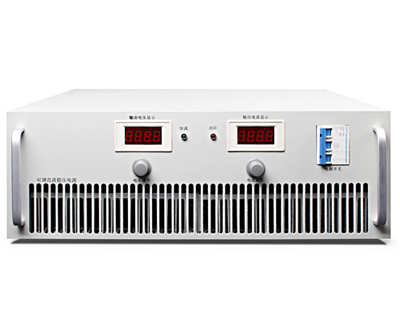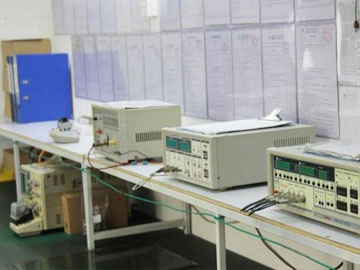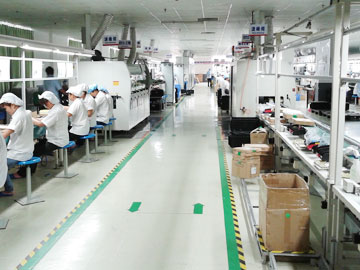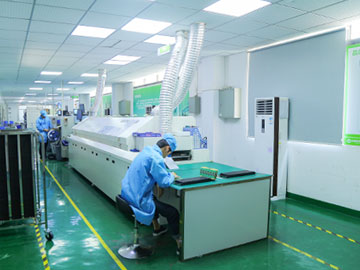Focus on solving DC power solutions
Create high-standard and reliable power products
Support Hotline:
+86-13902319159
+86-755-84868780

+86-13902319159
+86-755-84868780

XingZhongKe Power Technology Co., Ltd.Release Time:2019-10-27

In any switching power supply design, the physical design of the PCB board is the last link. If the design method is improper, the PCB may radiate too much electromagnetic interference, which will cause the power supply to work unstable. The following are the matters needing attention in each step analyze:
1. The design process from schematic to PCB
Establish component parameters -> input principle netlist -> design parameter settings -> manual layout -> manual wiring -> verify design -> review -> CAM output.
2. Parameter setting
The spacing between adjacent wires must meet electrical safety requirements, and for ease of operation and production, the spacing should also be as wide as possible. The minimum spacing must be at least suitable for the withstand voltage. When the wiring density is low, the spacing of the signal lines can be increased appropriately Large, the signal lines with high and low levels should be as short as possible and the spacing should be increased.Generally, the spacing of the traces is set to 8mil.
The distance between the edge of the inner hole of the pad and the edge of the printed board should be greater than 1mm, which can avoid the defects of the pad during processing. When the trace connected to the pad is thin, the connection between the pad and the trace should be designed In the shape of a drop, the advantage of this is that the pad is not easy to peel, but the trace and the pad are not easily disconnected.
Three, component layout
Practice has proved that even if the circuit schematic is designed correctly and the printed circuit board is not designed properly, it will have an adverse effect on the reliability of electronic equipment. For example, if the two thin parallel lines of the printed board are close together, a signal waveform will be formed. The delay of the transmission line forms the reflected noise at the terminal of the transmission line; the interference caused by the improper consideration of the power supply and the ground line will reduce the performance of the product.Therefore, when designing the printed circuit board, pay attention to adopting the correct method.
Each switching power supply has four current loops:
(1). Power switch AC circuit
(2). Output rectifier AC circuit
(3). Input signal source current loop
(4). Output load current loop
The input circuit charges the input capacitor through an approximate DC current, and the filter capacitor mainly serves as a broadband energy storage function; similarly, the output filter capacitor is also used to store high-frequency energy from the output rectifier and eliminate the DC energy of the output load circuit. Therefore, the terminals of the input and output filter capacitors are very important. The input and output current loops should only be connected to the power supply from the terminals of the filter capacitor respectively; if the connection between the input/output loop and the power switch/rectifier loop cannot be The terminal of the capacitor is directly connected, and the AC energy will be radiated into the environment by the input or output filter capacitor.
The AC circuit of the power switch and the AC circuit of the rectifier contain high-amplitude trapezoidal currents. The harmonic components of these currents are very high. The frequency is much greater than the fundamental frequency of the switch. The peak amplitude can be as high as 5 times the amplitude of the continuous input/output DC current. The transition time is usually About 50ns. These two loops are most prone to electromagnetic interference, so these AC loops must be laid out before the other printed lines in the power supply. The three main components of each loop are filter capacitors, power switches or rectifiers, and inductors. Or the transformers should be placed next to each other, and the component positions should be adjusted to make the current path between them as short as possible.
The best way to establish a switching power supply layout is similar to its electrical design. The best design process is as follows:
· Place the transformer
· Design the power switch current loop
· Design output rectifier current loop
· Control circuit connected to AC power circuit
· Design input current source loop and input filter
When designing the output load loop and output filter according to the functional unit of the circuit, when laying out all the components of the circuit, the following principles must be met:
(1) First, consider the size of the PCB. When the PCB size is too large, the printed lines will be longer, the impedance will increase, the anti-noise ability will decrease, and the cost will also increase; if the PCB size is too small, the heat dissipation will not be good, and the adjacent lines are susceptible to interference. The best shape is rectangular, the aspect ratio is 3:2 or 4:3, and the components located on the edge of the circuit board are generally not less than 2mm from the edge of the circuit board.
(2) When placing the device, consider future soldering, not too dense.
(3) Take the core components of each functional circuit as the center and lay out around it. The components should be evenly, neatly and compactly arranged on the PCB to minimize and shorten the leads and connections between the components, decoupling The capacitor should be as close as possible to the VCC of the device.
(4) For circuits that work at high frequencies, the distribution parameters between components should be considered. Generally, the circuit should be arranged in parallel as much as possible. In this way, it is not only beautiful, but also easy to install and solder, and easy to mass produce.
(5) Arrange the position of each functional circuit unit according to the circuit flow, so that the layout is convenient for signal circulation, and the signal is kept in the same direction as possible.
(6) The first principle of the layout is to ensure the wiring rate, pay attention to the connection of the flying line when moving the device, and put the devices with the connection relationship together.
(7) Reduce the loop area as much as possible to suppress the radiation interference of the switching power supply.
Four, wiring
The switching power supply contains high-frequency signals, and any printed line on the PCB can function as an antenna. The length and width of the printed line will affect its impedance and inductance, thereby affecting the frequency response. Even if it is printed by a DC signal The control line will also couple to the radio frequency signal from the adjacent printed line and cause circuit problems (or even radiate interfering signals again). Therefore, all printed lines that pass AC current should be designed as short and wide as possible, which means that it must be Place all the components connected to the printed line and other power lines very close. The length of the printed line is proportional to the inductance and impedance it exhibits, and the width is proportional to the inductance and impedance of the printed line. Inverse ratio. The length reflects the wavelength of the printed line response. The longer the length, the more frequency the printed line can send and receive electromagnetic waves. Low, it can radiate more radio frequency energy. According to the size of the printed circuit board current, try to thicken the width of the power line and reduce the loop resistance. At the same time, make the direction of the power line and the ground line consistent with the direction of the current. This helps to enhance the anti-noise ability.
Grounding is the bottom branch of the four current loops of the switching power supply. It plays a very important role as a common reference point for the circuit. It is an important method to control interference. Therefore, the placement of the grounding wire should be carefully considered in the layout, and the various Grounding mixing will cause unstable power supply. The following points should be paid attention to in the grounding design:
1. Correctly choose single point grounding
Generally, the common end of the filter capacitor should be the only connection point for other grounding points to couple to the AC ground of high current. Above, it is mainly considered that the current flowing back to the ground in each part of the circuit is changed, and the impedance of the actual flowing line will cause the change of the ground potential of each part of the circuit and introduce interference.
In this switching power supply, its wiring and the inductance between the devices have a small effect, and the circulating current formed by the grounding circuit has a greater impact on the interference. Connected to the grounding pin, the ground wires of several components of the output rectifier current loop are also connected to the grounding pins of the corresponding filter capacitors, so that the power supply is stable and not easy to self-excite. When it is not possible to achieve a single point, use the common ground Connect two diodes or a small resistor, in fact, it can be connected to a relatively concentrated piece of copper foil.
2. Make the ground wire as thick as possible
If the ground wire is very thin, the ground potential will change with the change of the current, causing the timing signal level of the electronic equipment to be unstable and the anti-noise performance to deteriorate. To make the wire, widen the width of the power and ground wires as much as possible. It is best to make the ground wire wider than the power wire. Their relationship is: ground wire> power wire> signal wire. The large area of ??the copper layer is used as a ground wire, and the unused places on the printed board are connected to the ground as a ground wire.
When performing global wiring, the following principles must also be followed:
(1). Wiring direction: From the perspective of the welding surface, the arrangement of the components should be as consistent as possible with the schematic diagram. The wiring direction is best to be consistent with the wiring direction of the circuit diagram, because various parameters are usually required on the welding surface during the production process. Therefore, this is convenient for inspection, debugging and maintenance in production (Note: It refers to the premise of meeting the circuit performance and the requirements of the whole machine installation and panel layout).
(2) When designing the wiring diagram, the wiring should not bend as much as possible, the line width on the printed arc should not be changed suddenly, the corner of the wire should be ≥90 degrees, and the line should be simple and clear.
(3). Cross circuits are not allowed in the printed circuit. For the lines that may cross, you can use "drilling" and "winding" to solve the problem. That is, let a certain lead from the gap under other resistors, capacitors, and triode pins. "Drilling" in the past, or "winding" from one end of a lead that may cross, in special circumstances, how the circuit is very complicated, in order to simplify the design, it is also allowed to use the wire jumper to solve the problem of the cross circuit. Because of the single-sided board, straight plug The component is located on the top surface, and the surface mount device is located on the bottom surface, so the in-line device can overlap with the surface mount device during layout, but the overlap of the pads should be avoided.
3. Input ground and output ground
This switching power supply is a low-voltage DC-DC. If you want to feed the output voltage back to the primary of the transformer, the circuits on both sides should have a common reference ground, so after laying copper on the ground wires on both sides, they must be connected together to form Common ground.
Five, check
After the wiring design is completed, it is necessary to carefully check whether the wiring design meets the rules set by the designer. At the same time, it is also necessary to confirm whether the rules formulated meet the requirements of the printed board production process. Generally check the line and line, line and component pad, line Whether the distance between the through hole, the component pad and the through hole, the through hole and the through hole is reasonable, and whether it meets the production requirements. Whether the width of the power line and the ground line is appropriate, and whether there is any way to widen the ground line in the PCB The place.
Note: Some errors can be ignored.For example, part of the outline of some connectors is placed outside the board frame, and errors will occur when checking the spacing; in addition, each time the wiring and vias are modified, the copper must be re-coated.
Six, review
According to the "PCB checklist", the content includes design rules, layer definitions, line widths, spacing, pads, and via settings. It is also important to review the rationality of the device layout, the wiring of the power supply, ground network, and the high-speed clock network. Wiring and shielding, placement and connection of decoupling capacitors, etc.
Seven, design output
Precautions for outputting Gerber files:
a. The layers that need to be output are wiring layer (bottom layer), silk screen layer (including top screen printing, bottom screen printing), solder mask (bottom solder mask), drilling layer (bottom layer), and a drilling file (NC Drill) )
b. When setting the Layer of the silk screen layer, do not select Part Type, select the top layer (bottom layer) and Outline, Text, Line of the silk screen layer
c.When setting the Layer of each layer, select the Board Outline. When setting the Layer of the silk screen layer, do not select the Part Type, select the Outline, Text, and Line of the top layer (bottom layer) and the silk screen layer.
d. When generating drilling files, use the default settings of PowerPCB and do not make any changes.

Xingzhongke has many years of experience in the supply of brands in the power supply industry and is a high-tech enterprise specializing in the production of power products.

The industry implements full-process production control, from raw materials to production to packaging and shipment, and has established a complete quality supervision and inspection system.

Xingzhongke Power has a professional distribution team that actively responds to customer feedback and needs to ensure that customers receive the products they need at the specified time.

It has advanced testing equipment and automated production equipment at home and abroad, and a professional design, development, management and operation team.

With the concept of mid-end price for high-end products as the core, we insist on cost control from raw materials to the production process.

Strive to achieve beyond what customers think, from customer order to product delivery. Provide your company with technical support and provide customers with high-quality butler-style services!